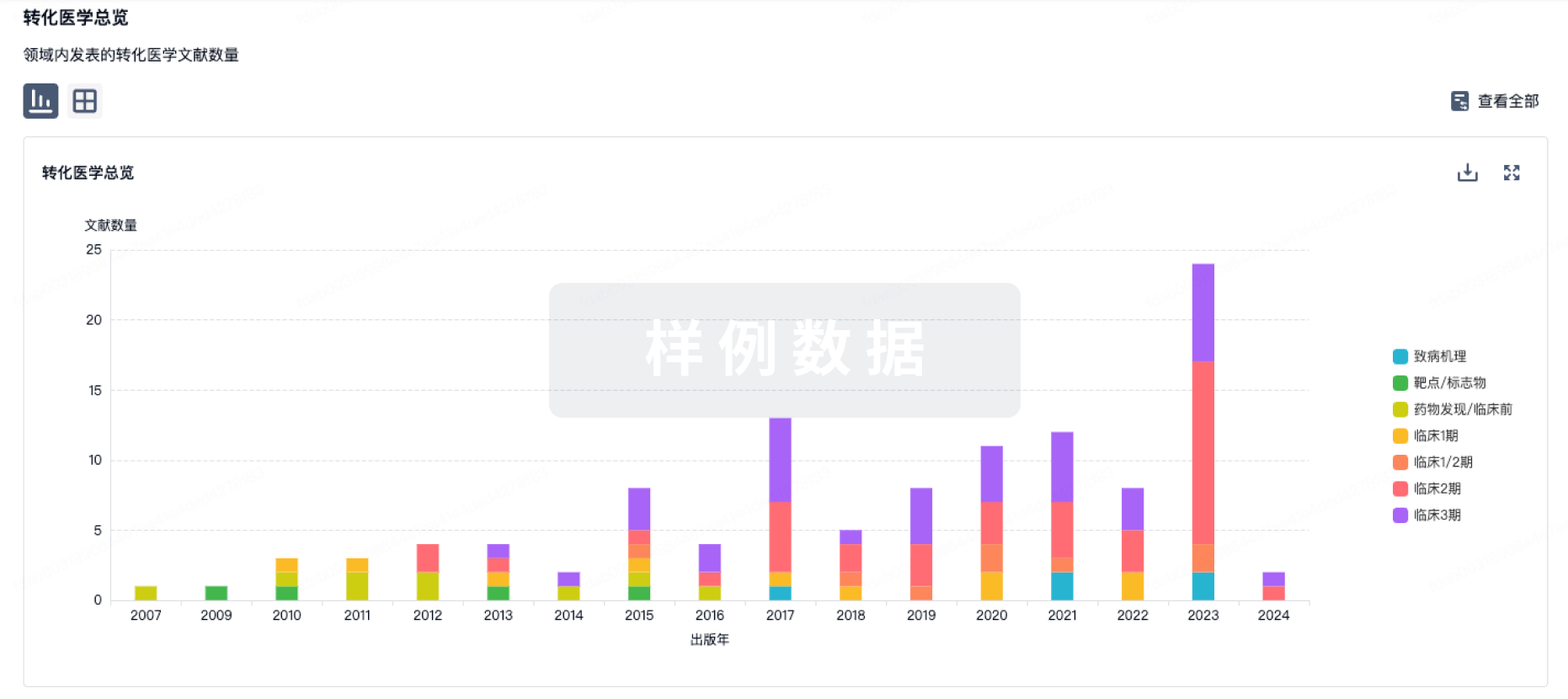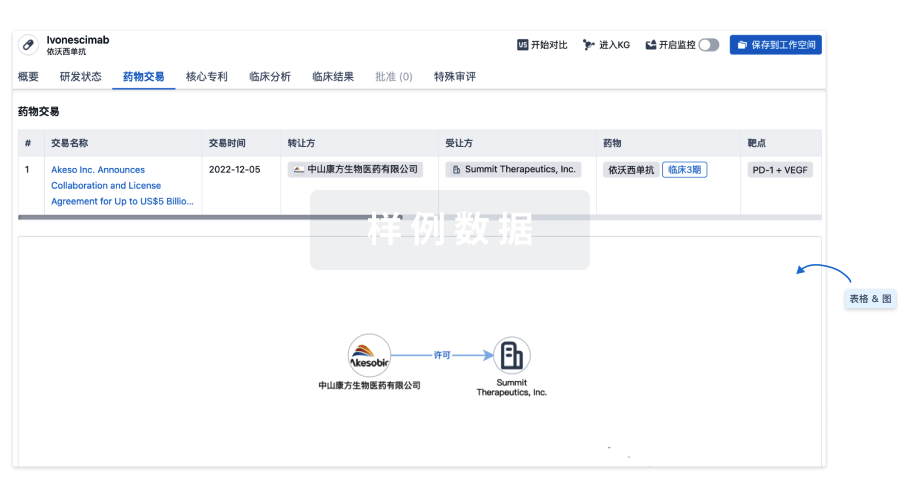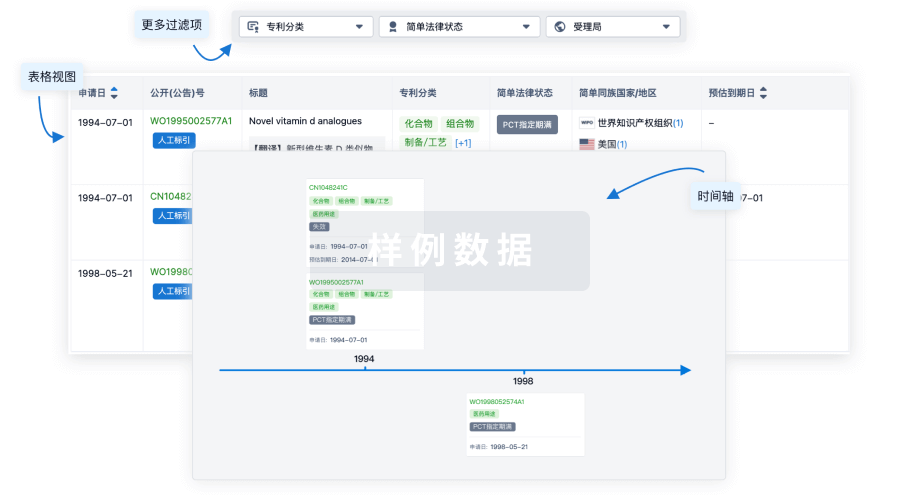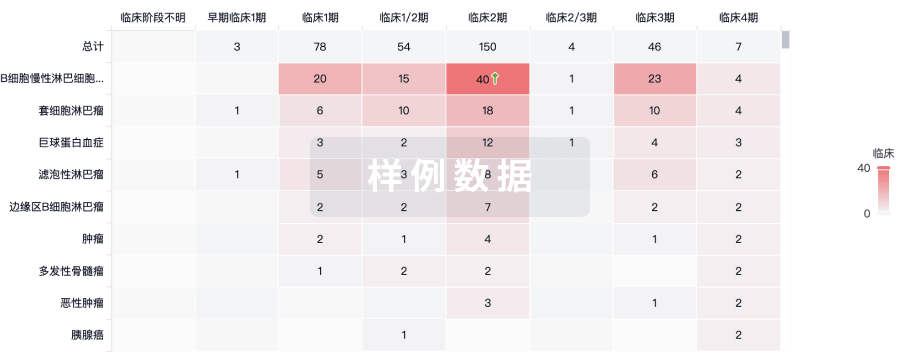预约演示
更新于:2025-07-19
ISOX-DUAL
更新于:2025-07-19
概要
基本信息
药物类型 小分子化药 |
别名- |
靶点 |
作用方式 抑制剂 |
作用机制 BRD4抑制剂(溴结构域蛋白-4抑制剂)、表观遗传学药物 |
治疗领域- |
在研适应症- |
非在研适应症- |
非在研机构- |
权益机构- |
最高研发阶段临床前 |
首次获批日期- |
最高研发阶段(中国)- |
特殊审评- |
结构/序列
分子式C31H41N5O3 |
InChIKeyHCDQWCDANVEBQR-UHFFFAOYSA-N |
CAS号1962928-22-8 |
关联
100 项与 ISOX-DUAL 相关的临床结果
登录后查看更多信息
100 项与 ISOX-DUAL 相关的转化医学
登录后查看更多信息
100 项与 ISOX-DUAL 相关的专利(医药)
登录后查看更多信息
6
项与 ISOX-DUAL 相关的文献(医药)2025-05-08·JOURNAL OF MEDICINAL CHEMISTRY
Structure-Guided Design of ISOX-DUAL-Based Degraders Targeting BRD4 and CBP/EP300: A Case of Degrader Collapse
Article
作者: Stewart, Helen ; Kollareddy, Madhu ; Joerger, Andreas C. ; Morley, Simon ; Brasher, Bradley ; Ott, Christopher J. ; Ojeda, Samuel ; Lineham, Ella ; Balourdas, Dimitrios-Ilias ; Felix, Robert ; Spencer, John ; Rajasekaran, Mohan B. ; Marsh, Graham P. ; Chevassut, Timothy J. T. ; Harrison, Drew A. ; Malik, Karim ; Maple, Hannah J. ; Edmonds, Anthony K. ; Graber-Feesl, Cari ; Cooper, Jeff ; Bennett, James ; Fedorov, Oleg
Degraders with dual activity against BRD4 and CBP/EP300 were designed. A structure-guided design approach was taken to assess and test potential exit vectors on the dual BRD4 and CBP/EP300 inhibitor, ISOX-DUAL. Candidate degrader panels revealed that VHL-recruiting moieties could mediate dose-responsive ubiquitination of BRD4. A panel of CRBN-recruiting thalidomide-based degraders was unable to induce ubiquitination or degradation of target proteins. High-resolution protein cocrystal structures revealed an unexpected interaction between the thalidomide moiety and Trp81 on the first bromodomain of BRD4. The inability to form a ternary complex provides a potential rationale for the lack of degrader activity with these compounds, some of which have remarkable affinities close to those of (+)-JQ1, as low as 65 nM in a biochemical assay, vs 1.5 μM for their POI ligand, ISOX-DUAL. Such a "degrader collapse" may represent an under-reported mechanism by which some putative degrader molecules are inactive with respect to target protein degradation.
2025-03-01·GENES TO CELLS
The HAT Inhibitor ISOX ‐DUAL Diminishes Ischemic Areas in a Mouse Model of Oxygen‐Induced Retinopathy
Article
作者: Takamura, Yoshihiro ; Oki, Masaya ; Nakanishi, Kengo ; Inatani, Masaru ; Nakano, Yusei
ABSTRACT:
Retinal ischemic disease results in significant visual impairment due to the development of fragile and disorganized, pathologically running blood vessels in the eye. Currently, the mainstay treatment for this disease is the intravitreal administration of anti‐VEGF drugs targeting vascular endothelial growth factor (VEGF), which induces angiogenesis. However, current anti‐VEGF drugs do not diminish the ischemic areas that lead to angiogenesis, making fundamental treatment challenging. Since retinopathy is an acquired disease caused by hypoxic stimulation from ischemia, we paid particular attention to histone acetylases. We conducted a drug screening experiment using a mouse model of oxygen‐induced retinopathy (OIR), which replicates retinal ischemic disease, through the intraperitoneal administration of 17 distinct inhibitors targeting histone acetyltransferases (HAT). The results indicated that, among the 17 inhibitors, only ISOX‐DUAL decreased neovascularization and ischemic regions. Furthermore, microarray analysis was conducted on the drug‐treated samples to refine genes altered by the administration of ISOX‐DUAL. There were 21 genes associated with angiogenesis, including Angpt2, Hmox1, Edn1, and Serpine1, exhibited upregulation in OIR mice and downregulation following treatment with ISOX‐DUAL. Furthermore, STRING analysis confirmed that the aforementioned four genes are downstream factors of hypoxia‐inducible factors and are assumed to be important factors in retinal ischemic diseases.
2017-07-13·Journal of medicinal chemistry1区 · 医学
Structure-Based Design of Highly Selective Inhibitors of the CREB Binding Protein Bromodomain
1区 · 医学
Article
作者: Denny, R. Aldrin ; Basak, Arindrajit ; Sahasrabudhe, Parag ; Liu, Shenping ; Pletcher, Mathew ; Chekler, Eugene L. Piatnitski ; Bonin, Paul ; Flick, Andrew C. ; Hay, Duncan A. ; Stock, Ingrid ; Coe, Jotham ; Langille, Jonathan ; Jones, Lyn H. ; Brennan, Paul E.
Chemical probes are required for preclinical target validation to interrogate novel biological targets and pathways. Selective inhibitors of the CREB binding protein (CREBBP)/EP300 bromodomains are required to facilitate the elucidation of biology associated with these important epigenetic targets. Medicinal chemistry optimization that paid particular attention to physiochemical properties delivered chemical probes with desirable potency, selectivity, and permeability attributes. An important feature of the optimization process was the successful application of rational structure-based drug design to address bromodomain selectivity issues (particularly against the structurally related BRD4 protein).
100 项与 ISOX-DUAL 相关的药物交易
登录后查看更多信息
研发状态
登录后查看更多信息
临床结果
临床结果
适应症
分期
评价
查看全部结果
| 研究 | 分期 | 人群特征 | 评价人数 | 分组 | 结果 | 评价 | 发布日期 |
|---|
No Data | |||||||
登录后查看更多信息
转化医学
使用我们的转化医学数据加速您的研究。
登录
或

药物交易
使用我们的药物交易数据加速您的研究。
登录
或

核心专利
使用我们的核心专利数据促进您的研究。
登录
或

临床分析
紧跟全球注册中心的最新临床试验。
登录
或

批准
利用最新的监管批准信息加速您的研究。
登录
或

特殊审评
只需点击几下即可了解关键药物信息。
登录
或

Eureka LS:
全新生物医药AI Agent 覆盖科研全链路,让突破性发现快人一步
立即开始免费试用!
智慧芽新药情报库是智慧芽专为生命科学人士构建的基于AI的创新药情报平台,助您全方位提升您的研发与决策效率。
立即开始数据试用!
智慧芽新药库数据也通过智慧芽数据服务平台,以API或者数据包形式对外开放,助您更加充分利用智慧芽新药情报信息。
生物序列数据库
生物药研发创新
免费使用
化学结构数据库
小分子化药研发创新
免费使用
